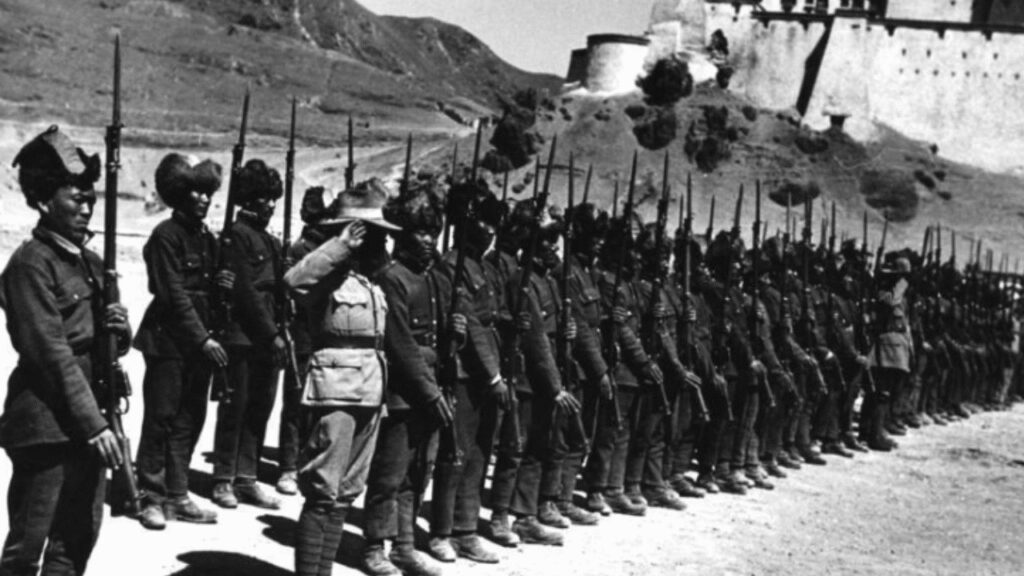The People’s Liberation Army (PLA) offensive in Tibet in 1950 fundamentally reshaped South Asian geopolitics.
Exactly 75 years ago the People’s Liberation Army (PLA) crossed the Jinsha River on 7 October 1950 under the watch of Mao Zedong, President of the People’s Republic of China (PRC), to invade Tibet after months of fruitless negotiations and subsequently annex it. This incident has changed the contours of South Asia’s geopolitics in a big way.
Two PLA units quickly surrounded the outnumbered Tibetan forces and captured the border town of Chamdo by 19 October, by which time 114 PLA soldiers and 180 Tibetan soldiers were killed or wounded. The fighting was concentrated in a border area, resulting in casualties on both sides. Following the military defeat, the captured Tibetan governor-general, Ngapoi Ngawang Jigme, was sent to Lhasa to negotiate with the Dalai Lama on the PLA’s behalf. The 17-Point Agreement: Tibetan representatives went to Beijing, where they were pressured into signing the 17-Point Agreement, which effectively incorporated Tibet into China.
The agreement paved the way for the establishment of Chinese military and administrative structures in Tibet, integrating it into the PRC. The Chinese response was that Tibet could modernise at its own pace as long as it embraced a Chinese identity. With no opportunity to consult with their government, the delegates were coerced into signing this agreement. Tenzin Gyatso, the 14th Dalai Lama, later distanced himself from the agreement. But the signing had altered Tibet’s trajectory as it acknowledged its identity as Chinese and reshaped the course of its history.
For several years, the Tibetan Government remained in place in the areas of Tibet where it had ruled prior to the outbreak of hostilities, except for the area surrounding Qamdo, that was occupied by the PLA in 1950, which was placed under the authority of the Qamdo Liberation Committee and outside the Tibetan Government’s control.
During this time, areas under the Tibetan Government maintained a large degree of autonomy from the Central Government and were generally allowed to maintain their traditional social structure. In 1956, Tibetan militias in the ethnically Tibetan region of eastern Kham just outside the Tibet Autonomous Region, spurred by PRC government experiments in land reform, started fighting against the government. The militias united to form Chushi Gangdruk Volunteer Force. When the fighting spread to Lhasa in March 1959, the Dalai Lama left Lhasa on March 17 with an entourage of twenty, including six Cabinet ministers, and fled Tibet.
Over the next decade, around 80,000 Tibetans followed Gyatso across the Himalayas into India. In 1961, United Nations General Assembly resolution publicly identified this mass migration as testament to the abuse of human rights in Tibet.
Both the Dalai Lama and the PRC government in Tibet subsequently repudiated the 17 Point Agreement, and the PRC government in Tibet dissolved the Tibetan Local Government. The legacy of this action continues to the present day. The Tibetan government in exile, the Central Tibetan Administration (CTA), continues to demand autonomy, independent status and religious freedom from China. Its annexation by PRC has led to “Sinicisation” of Tibet. The PRC government has forced cultural assimilation in Tibetan areas of China, including the Tibet Autonomous Region (TAR) and the surrounding Tibetan-designated autonomous areas. The Tibetans don’t have any administrative control over their own region as China enforces its laws on them.
According to the CTA, the government of Tibet in exile, China’s policy has allegedly resulted in the disappearance of elements of Tibetan culture; this policy has been called a “cultural genocide”. The government in exile says that the policies intend to make Tibet an integral part of China and control the desire for Tibetan self-determination. The 14th Dalai Lama and the CTA have characterized “Sinicisation” programmes as genocide or cultural cleansing in the context of Tibet.
The Dalai Lama’s government appealed to the United Nations for support, but the appeal failed due to diplomatic technicalities and the hesitation of key countries like Britain, India, and the United States, who had strategic interests or were hesitant to challenge China.
But since Tibet’s occupation, it has become a source of border dispute between India and China. The Tibet dispute was a major cause of the Sino-Indian War in 1962, escalating from border skirmishes after the Dalai Lama’s 1959 exile to India, which angered China. China viewed Tibet as an internal matter and was further provoked by CIA-backed Tibetan resistance and India’s “Forward Policy”.
The conflict culminated in a Chinese military offensive across the disputed borders in the Aksai Chin and North-East Frontier Agency (NEFA), leading to a brief but decisive war that saw China withdraw after securing significant territory.
Conflicts along India’s border with China revolve on two sizeable regions, namely Ladakh and Arunachal Pradesh. China says that the latter is a part of “Southern Tibet” and the former is a part of the Aksai Chin territory, which is under its administration. The most recent manifestation of these conflicts were the clashes between Indian and Chinese soldiers in the Indian Galwan valley in June 2020, which resulted in fatalities on both sides.
Such events demonstrate how Tibet has been and will continue to be a crucial component of India-China ties and a key issue in the context of their border dispute. As a result, it is crucial that going forward, India develops and implements a strong and unambiguous foreign policy on its diplomatic interactions with China, with the Tibet problem at the forefront of the conversation rather than as a secondary consideration.



